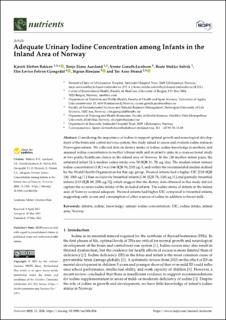| dc.contributor.author | Bakken, Kjersti Sletten | |
| dc.contributor.author | Aarsland, Tonje Eiane | |
| dc.contributor.author | Groufh-Jacobsen, Synne | |
| dc.contributor.author | Solvik, Beate Stokke | |
| dc.contributor.author | Gjengedal, Elin Lovise Folven | |
| dc.contributor.author | Henjum, Sigrun | |
| dc.contributor.author | Strand, Tor Arne | |
| dc.coverage.spatial | Norway | en_US |
| dc.date.accessioned | 2021-08-18T11:35:53Z | |
| dc.date.available | 2021-08-18T11:35:53Z | |
| dc.date.created | 2021-06-28T14:42:43Z | |
| dc.date.issued | 2021 | |
| dc.identifier.citation | Nutrients. 2021, 13 (6), . | en_US |
| dc.identifier.issn | 2072-6643 | |
| dc.identifier.uri | https://hdl.handle.net/11250/2770091 | |
| dc.description.abstract | Considering the importance of iodine to support optimal growth and neurological development of the brain and central nervous system, this study aimed to assess and evaluate iodine status in Norwegian infants. We collected data on dietary intake of iodine, iodine knowledge in mothers, and assessed iodine concentration in mother’s breast milk and in infant’s urine in a cross-sectional study at two public healthcare clinics in the inland area of Norway. In the 130 mother–infant pairs, the estimated infant 24-h median iodine intake was 50 (IQR 31, 78) µg/day. The median infant urinary iodine concentration (UIC) was 146 (IQR 93, 250) µg/L and within the recommended median defined by the World Health Organization for this age group. Weaned infants had a higher UIC [210 (IQR 130, 330) µg/L] than exclusively breastfed infants [130 (IQR 78, 210) µg/L] and partially breastfed infants [135 (IQR 89, 250) µg/L], which suggest that the dietary data obtained in this study did not capture the accurate iodine intake of the included infants. The iodine status of infants in the inland area of Norway seemed adequate. Weaned infants had higher UIC compared to breastfed infants, suggesting early access and consumption of other sources of iodine in addition to breast milk. | en_US |
| dc.description.sponsorship | This work was supported by Innlandet Hospital Trusts research fund by Grant number 150421, Regional Research Fund Innlandet by grant number 286442, and OsloMet. | en_US |
| dc.language.iso | eng | en_US |
| dc.rights | Navngivelse-Ikkekommersiell 4.0 Internasjonal | * |
| dc.rights.uri | http://creativecommons.org/licenses/by-nc/4.0/deed.no | * |
| dc.subject | infants | en_US |
| dc.subject | iodine | en_US |
| dc.subject | knowledge | en_US |
| dc.subject | urinary iodine concentration | en_US |
| dc.subject | UIC | en_US |
| dc.subject | iodine intake | en_US |
| dc.subject | inland area | en_US |
| dc.subject | Norway | en_US |
| dc.title | Adequate urinary iodine concentration among infants in the inland area of Norway | en_US |
| dc.type | Peer reviewed | en_US |
| dc.type | Journal article | en_US |
| dc.description.version | publishedVersion | en_US |
| dc.rights.holder | Copyright © 2021 by the authors.
Licensee MDPI, Basel, Switzerland. This article is an open access article distributed under the terms and conditions of the Creative Commons Attribution (CC BY) license (https://creativecommons.org/licenses/by/4.0/). | en_US |
| dc.source.pagenumber | 12 | en_US |
| dc.source.volume | 13 | en_US |
| dc.source.journal | Nutrients | en_US |
| dc.source.issue | 6 | en_US |
| dc.identifier.doi | 10.3390/nu13061826 | |
| dc.identifier.cristin | 1918992 | |
| cristin.ispublished | true | |
| cristin.fulltext | original | |
| cristin.qualitycode | 1 | |

